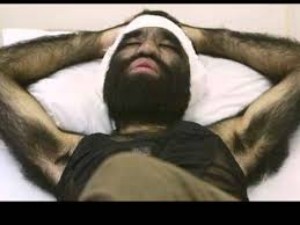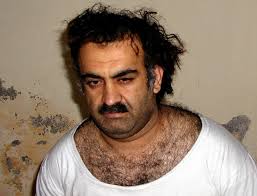A year after I wrote this post, an interesting new study comcluded that hair follicles across the body communicate with each other! Truly astounding.
Scalp Hair Loss :-( Back Hair Gain :-(
Around the year 2000, I started noticing that the vast majority of people that I saw in the gym or pool who had very hairy backs also tended to be heavily balding. If I had to put a figure to it, I would guess that 75 percent of men with excessive body hair (especially hairy backs) tend to be balding severely.
I saw a similar, but weaker correlation between those with substantial chest hair and scalp hair loss. In contrast, for those without any back or chest hair at all, the balding rate is extremely low. Perhaps less than 25 percent when it comes to young to middle-aged men. I doubt that I am off by much in both my above percentage estimates. Past studies also confirm that androgens stimulate beard growth, but suppress scalp hair growth.
Besides at the gym and in the pool, I have also noticed this trend among my own immediate family members and in-laws. My father has zero back hair and very little chest hair, but he had an absolutely stellar head of hair into his 60s. Even in his early 70s, he still has better hair than I have in my 30s. And of course I have a lot more body hair then him. My brother-in-law went bald in his 20s, and has an extremely hairy back. Same correlation with several of my unlucky friends.
Hairy Balding Athletes
When I first started noticing this phenomenon, I was a big tennis fan. The two superstars of the game at the time, Andre Agassi and Pete Sampras, were both very hirsute in their bodies. And, not surprisingly, both were balding on their scalps. Agassi used to wax his chest and back hair regularly, so some of his topless photos are deceptive.
Since retiring, balding Sampras has been rumored to have had one or several hair transplants. I would guess that his scalp would look more like his father’s Norwood 6 one were it not for the transplant(s).

Lucky on the Scalp, Lucky on the Back
Native Americans/American Indians (who are genetically related to East Asians) have almost zero body hair. Not surprisingly, I have never seen a balding young full-blooded native American. The one native American that I did see with major hair loss was half Caucasian.
Chinese, Japanese and Korean people (all part of the East Asian family) rarely have chest or back hair, and tend to have much less balding in comparison to other races. Especially at younger ages.
It should be noted that even among Asians, there are some hirsute exceptions to this stereotype. One publicized recent case covered a Chinese girl with hypertrichosis who was raising money for laser hair removal.

Finasteride Works Better for People with Excessive Body Hair
Around a year ago, I discovered a very interesting 2014 study from Japan. It concluded that people with more body hair tended to respond better to finasteride treatment for androgenetic alopecia. In my opinion, this is a fascinating discovery. Men who were “pileous” in areas other than the scalp might benefit more from dihydrotestosterone reduction.
It should be noted that very few Japanese people are likely to be very pileous or hirsute. I wish someone would do the same study on very hairy Caucasian men. I am including Armenians, Greeks, Persians, Turks, Afghans, East Indians and South Asians, Middle Easterners and so on as part of the extended Caucasian race definition here.
Many Finasteride and Dutasteride Users Have Seen a Reduction in Body Hair
Over the years, I have read countless testimonials on various hair loss forums of people who were taking 5α-reductase inhibitors finasteride or dutasteride seeing a significant reduction in body hair. People taking anti-androgens such as spironolactone and cyproterone acetate also report similar side effects.
However, to me, the surprising thing is that there are probably far more people who see no obvious reduction in body hair while on finasteride or dutasteride. I would have guessed that drastically reducing DHT levels is bound to reduce body hair in most people. Especially in those who have a ton of it to start off with? Yet, less than one-third of such hirsute people seem to see a reduction in body hair when on those drugs.
In any case, below are a few recent examples of people who noticed a reduction in body hair while on finasteride or dutasteride:
- In an excellent recent thread worth bookmarking, HLT forum member “dnpuntold” stated: “body hair looks a lot thinner and less which is nice since I’m a freaking gorilla.”
- On this very blog, in the comments to my post on the cost of generic finasteride, “paddy” stated: “I have been taking Propecia (non generic) for 18 yrs, I agree with the “hold the line” comment above. It pretty much stopped by hair loss when I started it. Have experienced no negative side effects as far as I can tell. But a nice bonus is that much of my other body hair (back, butt, arms, chest, etc) has thinned dramatically. Its as if it reapportioned that hair back to my head. Was a welcome side effect.”
- Also on this very blog, in the comments to my post on dutasteride success and failure stories, six (!) people thus far have mentioned body hair reduction after taking Avodart.
Do Men with Excess Body Hair Have Higher Testosterone and DHT Levels?
One of the biggest myths ever purported in the hair loss world is that balding men are more virile and have higher levels of testosterone. This is not true.
I also do not think that balding men have significantly higher levels of dihydrotesterone (DHT) in comparison to non-balding men. Keep in mind that I have not read any data on that subject. What is true is that balding men’s scalp hair follicles are more sensitive to the damaging effects of DHT.
For me, the more interesting thing is that it seems like balding men’s body hair is also more sensitive to the effects of DHT. Albeit, in the opposite direction, unfortunately. DHT seems to make a high proportion of balding men turn hirsute and grow copious amounts of body hair.
Skepticism on the Hirsutism vs. Androgentic Alopecia Correlation
In the past, I have talked to two experienced hair transplant surgeons about this phenomenon and theory of mine. To my surprise, both have told me that they do not see such a correlation. i.e., regarding men with hairy backs and chests being much more likely to bald then men without hairy backs and chests. I remain 100 percent convinced of such a correlation.
In recent years, I have also read many hair loss forum members suggest the same thing. However, since there are always exceptions to the rule (e.g., balding Asians without hair backs), this correlation theory does not get as much attention as it should. There is always some person who will ruin a thread on this subject. Usually, by writing: “I have no body hair and am still balding. So I do not buy this theory!”
Exception: Khalid Sheikh Mohammed has more scalp hair then would be expected based on his plentiful body hair. He is still balding from behind per other photos.

Body Hair Transplants (BHT)
In the original headings for the first two sections of this post, I implied that people with hairy backs were lucky. I then added a question mark (?) at the end. I have since changed those headings due to them becoming too lengthy and confusing.
My reasoning for this ambiguity was due to two contradicting phenomena:
- Most people with robust back hair would probably consider themselves unlucky. Hirsutism and hypertrichosis are usually not desired by most men and women.
- A recent trend in the hair transplant world has resulted in many people being grateful to have more body hair. More on this body hair transplantation phenomenon below.
This trend involves moving body hair to balding regions of the scalp, and is termed as body hair transplants (BHT). I have discussed BHT a few times over the years, and will have more posts on the subject in the future.
For now, its worth noting that only certain types of body hair are usually worth transplanting. Beard, chest and back hair seem to be the most utilized, in order of importance and desirability.
Body hair will never be as good as scalp hair that is moved from the permanent donor region at the back of the head. Nevertheless, there are now 100s of video documented cases online of people who have been happy with body hair transplants.
For people with very limited scalp donor hair (i.e., those with very extensive balding patterns), robust thick back hair and chest hair might now be considered to be a lucky thing! Dr. Ray Wood’s first BHT patient video is worth watching.
Hairy Balding Women
This post has mostly focused on men. This is because I doubt that there are many women who have their backs covered with thick lengthy hair. Some women do have thick beard and chest hair growth, but this is a rarity.
It should be noted that a high proportion of balding women also complain of excess body hair. Usually in areas other than the back. Many of these women suffer from a condition called polycystic ovary syndrome (PCOS). This hormonal disorder causes women to have high levels of male hormones. Here is a good resource for such women.
Last and Definitely the Least: Ernie Primeau
In the history of the online hair loss world, there has never been anyone more insane and crazier than a certain Mr. Ernie Primeau. I briefly discussed him in a post here. Ernie holds the all-time record for number of hair loss forum and hair loss newsgroup posts. Especially in the alt.baldspot newsgroup. A record that will never be surpassed by another human being.
Even into his old age, the man is still present online and continues to promote his theory: removing all of ones body hair via plucking will regrow scalp hair!! Of course I do not believe this possibility. However, perhaps it might very well have been Mr. Primeau who got me thinking about the inverse correlation between body hair and scalp hair over a decade ago.
I am pretty sure that it was my fellow gym and pool members and family members. But my memory could be incorrect. In any event, I hope to never mention Ernie again on this blog after today.